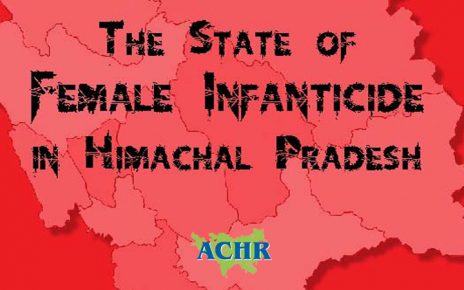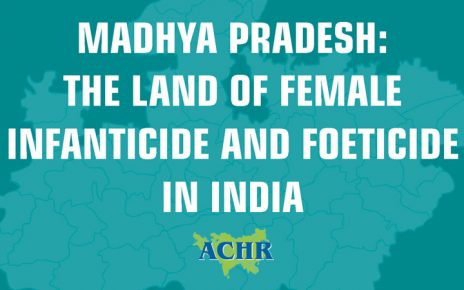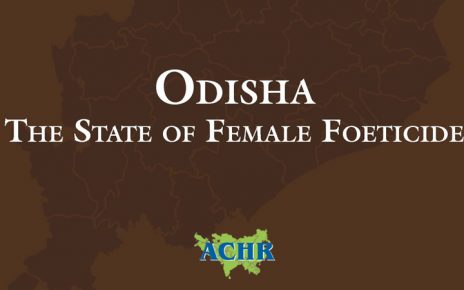Child Sex Ratio (CSR) i.e. the number of girls per 1,000 boys in the age group 0-6 years has reached alarming proportion in India. Haryana has the lowest CSR among the States and Union Territories in India.
As per the Government of India, “some of the reasons for neglect of girl child and low child sex ratio are son preference and the belief that it is only the son who can perform the last rites, that lineage and inheritance runs through the male line, sons will look after parents in old age, men are the bread winners etc. Exorbitant dowry demand is another reason for female foeticide/infanticide. Small family norm coupled with easy availability of sex determination tests may be a catalyst in the declining child sex ratio, further facilitated by easy availability of Pre-conception sex selection facilities”. These harmful practices against girls and women have been integral part of India’s cultures from time immemorial. Further, many of these discriminatory practices were legalised in independent India and women were not allowed to inherit properties until the Hindu Succession (Amendment) Act, 2005 came into force in September 2005. The dowry system makes daughters an unaffordable economic burden leading to son preference and it remains the principal cause of female foeticide in India.
According to the Ministry of Health and Family Welfare, “Easy availability of the sex determination tests and abortion services may also be proving to be catalyst in the process, which may be further stimulated by pre-conception sex selection facilities. Sex determination techniques have been in use in India since 1975 primarily for the determination of genetic abnormalities. However, these techniques were widely misused to determine the sex of the foetus and subsequent elimination if the foetus was found to be female.”
During 1971 census itself, the period prior to use of ultrasound machines for sex selections, the CSR of 898 girls per 1,000 boys was already highly unsatisfactory in Haryana. The CSR increased to 902 in 1981 but it hit the rock bottom of 819 in 2001 as a consequence of the use of diagnostic technology to detect the sex of the foetus very early during pregnancy. Although the CSR increased from 819 in 2001 to 834 in 2011, Haryana still has the lowest (834) CSR as per 2011 census among all the states and Union Territories of India. It is clear Haryana is far from reaching CSR of 1971 level.
The sex ratio in Haryana has fallen so low that men are unable to find brides. According to a media report, around 13.5% of Haryana’s young men between the age group of 25 and 29 were unmarried in 2010, primarily due to lack of brides. Unmarried men in Jind district (which had 871 females per 1,000 males) have even formed “Jind Kunwara Union” (Jind Bachelors Union) and demanded “brides” in lieu of their votes ahead of the Parliamentary elections of May 2014. As a result, women including minor girls are being bought and trafficked from other states of India including North Eastern states like Assam and Tripura to be brides for men in Haryana.
Because of Haryana’s infamy in female foeticide/infanticide, Prime Minister Narendra Modi chose to launch his government’s ambitious programme “Beti Bachao, Beti Padhao” (Save girl child, Educate girl child) from Panipat on 22 January 2015, exhorting people to save the girl child and educate her. Out of 100 districts selected to be targeted under the Beti Bachao, Beti Padhao programme, highest number of districts are from Haryana (12), followed by Punjab (11) and Uttar Pradesh, Rajasthan & Maharashtra (10 each), among others.
Yet, the manner in which the Ladli Scheme, the flagship programme of Haryana Government for retention of girl child, is being implemented evokes little confidence. The financial incentive of Rs 5,000/- per year for five years i.e. Rs 25,000 for two girls is too less an incentive to encourage even poor families to give birth to more girl children and prevent foeticide and infanticide. The Ladli Scheme is too restrictive as it disqualifies a single girl child as well as more than two girls in a single family. More strangely, in case of death of either of the two girl child, the enrollment as a beneficiary under the Group Scheme Ladli-LIC of India is cancelled with immediate effect and the money is transferred back to the Government, thereby depriving the surviving girl.
During 2005-06 to 2014-15, a total of 2,36,311 girl children have been reportedly provided benefits under the Ladli Scheme i.e. an average of 23,631 beneficiaries per year. During the same period the Haryana government claimed to have spent Rs 39,940 lakhs under the Ladli Scheme However, doubts remains regarding the exact number of beneficiaries.
Implementation of the Ladli Scheme has been fraught with mismanagement and irregularities.
The Comptroller and Auditor General of India (CAG) had found a number of irregularities in the Ladli Scheme implementation in three test checked districts of Karnal, Hisar and Jind. In its “Report of the Comptroller and Auditor General of India on Social, General and Economic Sectors (Non-Public Sector Undertakings) for the year ended 31st March 2014 of Government of Haryana“, the CAG stated that in 2,358 cases membership certificates supplied by the Life Insurance Corporation (LIC) to Programme Officer (PO), Jind in November 2013, date of birth of the beneficiary was not mentioned, in absence of which it would be difficult to ensure when the beneficiary would attain the age of 18 years. Further, the CAG found that the District Programme officers (DPOs) had not claimed refunds in 538 death cases (Jind: 306 cases, Karnal: 116 and Hisar: 116 cases) from the LIC. After the CAG brought the issue to the notice, the DPOs claimed and received refund of Rs 37.12 lakh from LIC along with interest in respect of 538 death cases. Obviously, the surviving girls were denied the benefits.
The report by the Audit Officer of the Office of the Principal Accountant General, Haryana is equally telling about irregularities. The Audit Officer found irregularities in the expenditure of Rs 809.90 lakhs which was said to have been deposited in the name of beneficiaries during 2009-10 to 2012-13. No record was maintained in the office of DPO, ICDS Rewari to determine as to whether both of the girl children (beneficiaries) are alive. Neither was there any register or record to prove that the beneficiaries were enrolled in Anganwadi Centres or Schools.
The Women and Child Development Department, Haryana Government refused to provide the Utilization Certificates on the flimsy ground that the Utilization Certificates do not come under the Right to Information Act, 2005. The District Programme Officer, Women and Child Development of Rewari district stated that it had spent Rs 15,33,45,430/- from 2005-2006 to 2015-2016 but refused to provide the Utilization Certificates. When specifically asked to supply Utilization Certificates the one line reply was “whatever had been received was spent”. The refusal to provide Utilisation Certificates raises doubts about actual utilisation.
The implementation of the Preconception and Pre-Natal Diagnostic Techniques (Prohibition of Sex Selection) Act, 1994 (PCPNDT Act) remains extremely poor despite rampant violations in the State. The Health Minister of India Mr J P Nadda informed in the Rajya Sabha (Upper House) on 3 March 2015 that a total of 206 convictions have been secured under the PCPNDT Act in India during 2009 to December 2014. Out of these, 54 convictions were secured in Haryana including 4 in 2010; 7 in 2011; 38 in 2013 and 5 in 2014. The National Crime Records Bureau (NCRB) in its annual reports states that during 2005 to 2014, a total of 91 cases of foeticide were recorded in Haryana, including 8 cases in 2005; 9 cases in 2006; 4 cases in 2007; 5 cases in 2008; 3 cases in 2009; 2 cases in 2010; 5 cases in 2011; 28 cases in 2012; 21 cases in 2013 and 6 cases in 2014 were recorded. During the same period, the NCRB also recorded 25 cases of infanticide including nil in 2005; 10 in 2006; 1 in 2007; 4 in 2008; nil in 2009; 7 in 2010, nil in 2011, 2012 and 2013; and 3 in 2014.
The Medical Termination of Pregnancy Act (MTP Act), 1971 (amended in 2002) allows termination of pregnancies in certain circumstances. A total of 1,36,163 medical termination of pregnancies were performed in Haryana during 2008-09 to 2012-13 under the MTP. These included 29,656 terminations of pregnancies in 2008-09; 25,726 in 2009-10; 27,085 in 2010-11, 27,808 in 2011-12, and 25,888 in 2012-13.19 However, there were also reports of abuse of the MTP for sex selective abortion as cited in this report.
Conclusion and recommendations
As Prime Minister Narendra Modi while launching “Beti Bachao-Beti Padhao” (Save girl child, educate girl child) campaign at Panipat in Haryana on 22 January 2015 stated “Our mental illness is responsible for this poor sex ratio. We give a lot of importance to boys. Many women also do this. But for how long will we look at girls as paraya dhan’? [some other’s property] For every 1,000 boys born, 1,000 girls should also be born. I want to ask you if girls are not born, where will you get your daughters-in-law from”?
There is no doubt that any programme that seeks to ensure retention of female foetuses ought to address the burden of marriage.
Asian Centre for Human Rights recommends the following to the State Government of Haryana:
- Revise the Ladli Scheme to increase the amount for post birth benefits and further provide scholarship for education as well as additional financial assistance for marriage of the surviving girls;
- Expand the coverage of the Ladli Scheme to include all girl children;
- Remove the condition with retrospective effect which provided under the Ladli Scheme that upon the demise of either of the girl child the accumulated benefits under the scheme shall be forfeited by the girls’ parents and transferred back to the Government;
- Issue necessary order to restore the benefits of the Ladli Scheme to all beneficiaries including at least 538 beneficiaries as identified by the CAG in three districts 21 who were denied benefits as per Rule 2(g) and Rule 3(e) of the Ladli Scheme Rules, 2005 notified on 17th November 2005 which stated, “In case of death of either of the girl the incentive shall be stopped with immediate effect. However, the same will be restored from the date it was discontinued on birth of another girl child.”;
- Link the Ladli Scheme with all Anganwadi Centres and Schools to monitor the status of the beneficiaries;
- Undertake specific programme for increasing coverage of all families under the Ladli Scheme by connecting the programme with all hospitals/ primary health centres;
- Digitalise the list of beneficiaries and related information, funds sanctioned and utilization certificates of the Ladli Scheme and upload the same in the website of the District concerned; and
- Undertake effective measures to monitor and ensure proper implementation of the PCPNDT Act and MTP Act.




